Montana Gets Glowing Report from Labor Department
“Montana is enjoying one of the strongest economic recoveries in the nation,” announced Laurie Esau, Commissioner of the Montana Department of Labor & Industry with the release of a state of the state’s economy report.
The report shows that Montana has had the third highest recovery in payroll jobs since the start of the pandemic . Total employment is more than 99.5 percent recovered from the pandemic, and since January the number of Montanans receiving unemployment benefits has plummeted 87 percent.
The state has also had strong wage growth, growing at 7.9 percent in 2020, and the fastest personal income gains of any state in the nation.
As Labor Day rolled around in Montana, vaccinations had became available and business restrictions lifted, Montanans returned to normal business activity, and were celebrating the ability to attend restaurants, concerts, and social activities. The release of this pent-up demand, augmented by economic stimulus, and higher income, have contributed to surging consumer demand, leaving businesses scrambling to bring on enough workers to meet customer needs. Tight labor markets, already evident prior to COVID-19, once again became the largest challenge to the state’s economic growth.
Highlights include:
•The rate of new businesses skyrocketed to the fastest rate in ten years, with over 3,500 new businesses created in 2020
.•Montana’s startups are more successful than the national average, and the pandemic had little impact on the rate of business closure for firms created within the last ten years.
•Montana has the 4th highest rate of business ownership in the nation, with 6.3% of Montana households reporting income from a business or farm.
•Montana posted the 3rd best payroll employment recovery among states since the start of the pandemic recession, and the 8th best recovery in total employment.
•The pandemic recession averaged job gains over 2,700 per month since the trough, a much faster recovery than the average of 500 jobs gained per month during the recovery from the 2008 recession.
•Both payroll and total employment levels are within 1% of the pre-recession peak.
•Montana’s real GDP growth from 2019 to 2020 ranked 20th among states, and likely made a full recovery in the 2nd quarter of 2021.
•Montana ranked 1st among states for personal income growth in 2020, growing 8.4% to $57.6 billion.
•Business owner income increased by 10%, or $506 million, bolstered by the Paycheck Protection Program and the Coronavirus Food Assistance Program.
•Wages paid to Montana workers surged, posting a 7.2% increase ($1.7 billion) for the year ending 2021Q1. Increased wage earnings are an important component needed to drive future business demand and are vital to increasing the standard of living for most Montanans.
•Montana ranks 8th among states for the fastest average annual wage growth over the last 10 years.
•Average annual wages in payroll jobs increased by 7.9% in 2020 (up to $48,400), over double the wage growth rates posted in prior years.
Real wage growth, or the amount of wage growth that exceeds inflation, was 6.6% in 2020
•The unemployment rate dropped quickly after the pandemic recession, reaching 3.6% in July 2021. Prior recessions took much longer for unemployment to return to normal levels.
Labor productivity soared as workers moved into remote work, increasing by 3.9% for the year ending 2021Q1.
Despite the strong economic recovery, challenges remain, particularly labor shortages and the impacts of rising prices on businesses and workers:
Inflation has spiked, with prices increasing over 5% during the summer of 2021, leaving consumers paying more for housing and gasoline, among other goods. Over the two years ending June 2021, hourly wages have increased by 8.7% while the price level has increased by 6.1%, resulting in a 2.6% increase in the real hourly wage.
Housing prices have also risen, with Montanan’s typical home price up 10.3% to $327,000 for the year ending June 2021, leaving many communities concerned about affordable housing.
Thousands of workers left the labor force during the last year due to fears of contracting COVID-19 and a lack of childcare. These workers must be reengaged in our economy to help fill unmet worker demand. Many of these workers have already come back into the economy as of July, with the labor force only 0.5% lower than its pre-recession peak.
If Montana’s labor force participation rate was the same now as before the pandemic, 11,331 more workers would be available to fill openings.
The average work week in Montana fell during the pandemic, moving from 33.4 hours per week in 2019 to 32.8 hours per week in 2020. Moving more part-time employees to full-time could address many workforce shortages.
Over 20% of the workforce is 60 years or older and preparing for retirement. Among those not retired, family care is the main reason for not participating in the labor force.
The report suggested, there are several solutions to the worker shortage, including increasing worker productivity through training and automation, tapping into underutilized labor sources (such as those living in rural areas or reservations, disabled, or facing barriers to work), and ensuring that workers have the incentive to move out of unemployment to work. With the resiliency and determination Montanans have shown throughout the last year, there can be no doubt that these future challenges will also be resolved, moving Montana’s economy into a more profitable future.


0 comments